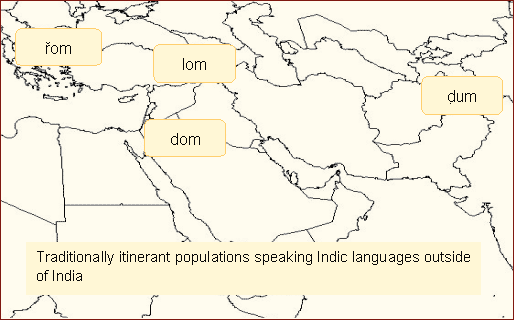History of the Romani language
Origins
Romani is the only Indo-Aryan language that has been spoken exclusively in Europe since the middle ages. It is part of the phenomenon of Indic diaspora languages spoken by travelling communities of Indian origin outside of India. The name Rom or Řom, which is the self-designation of the speakers, has related cognates in the names of other travelling (peripatetic) communities that speak Indian languages or use an Indic-derived special vocabulary: The Lom of the Caucasus and Anatolia insert Indic vocabulary into their variety of Armenian. The Dom of the Near East, originally metalworkers and entertainers, speak Domari, one of the most conservative modern Indo-Aryan languages. In the Hunza valley in the north of Pakistan there is a population called the Ḍum, who are also metalworkers and musicians, and who speak a Central Indic (i.e. not a local) language. Based on the systematicity of sound changes attested in these languages, we know with a fair degree of certainty that these names all derive from the Indian term ḍom.
In various parts of India itself, groups known as Ḍom are castes of commercial nomads. References to the Ḍom (also called Ḍum or Ḍōmba) are made already by a number of medieval writers in India, such as Alberuni (writing in about 1020 CE), the grammarian Hemachandra (around 1120 CE), and the Brahmin historian of Kashmir, Kalhana (1150 CE). They all describe the Ḍom as a low-status caste whose typical trades included cleaners, sweepers, musicians, singers, jugglers, metalworkers and basket-makers, in some areas also seasonal farm-workers. Similar occupations are still reported for the Ḍom in modern India, whose total number was last recorded in the 1901 census at over 850,000 (according to G. S. Ghurye, 1979). The self-designation ḍom > řom thus appears to have originally been a caste-designation, used in different regions by different populations with similar types of trades. These populations spoke, and still speak, distinct languages, although their languages all belong to the Indic (Indo-Aryan) language family and so are related.

Map 1

